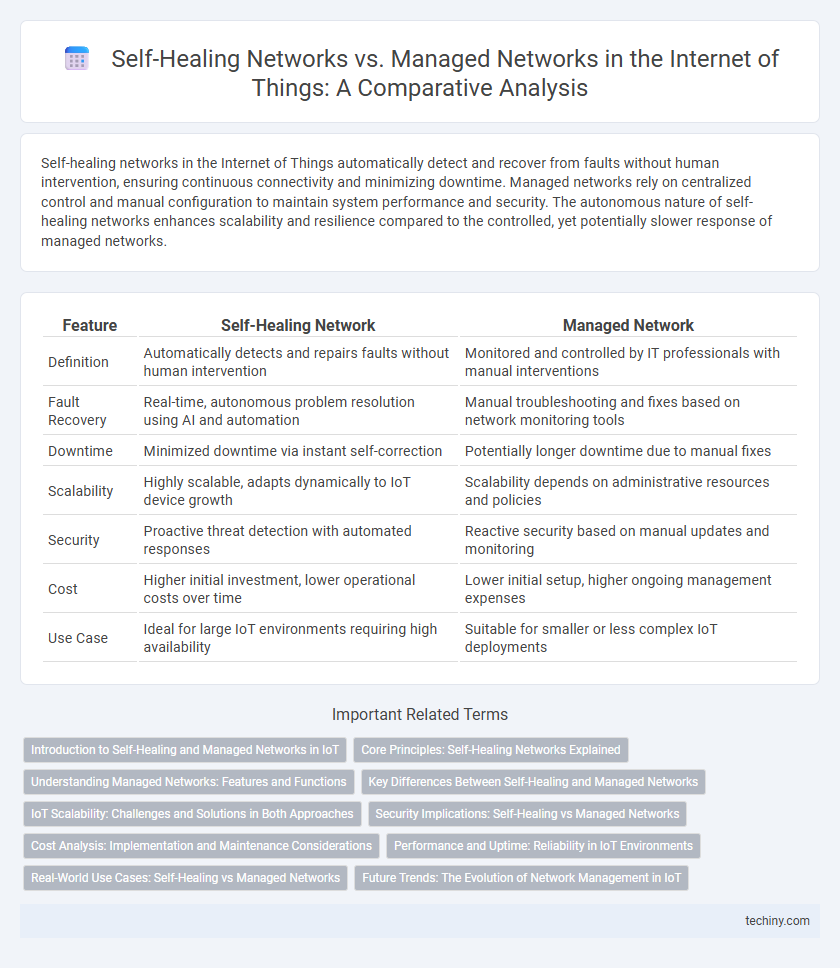Self-healing networks in the Internet of Things automatically detect and recover from faults without human intervention, ensuring continuous connectivity and minimizing downtime. Managed networks rely on centralized control and manual configuration to maintain system performance and security. The autonomous nature of self-healing networks enhances scalability and resilience compared to the controlled, yet potentially slower response of managed networks.
Table of Comparison
| Feature | Self-Healing Network | Managed Network |
|---|---|---|
| Definition | Automatically detects and repairs faults without human intervention | Monitored and controlled by IT professionals with manual interventions |
| Fault Recovery | Real-time, autonomous problem resolution using AI and automation | Manual troubleshooting and fixes based on network monitoring tools |
| Downtime | Minimized downtime via instant self-correction | Potentially longer downtime due to manual fixes |
| Scalability | Highly scalable, adapts dynamically to IoT device growth | Scalability depends on administrative resources and policies |
| Security | Proactive threat detection with automated responses | Reactive security based on manual updates and monitoring |
| Cost | Higher initial investment, lower operational costs over time | Lower initial setup, higher ongoing management expenses |
| Use Case | Ideal for large IoT environments requiring high availability | Suitable for smaller or less complex IoT deployments |
Introduction to Self-Healing and Managed Networks in IoT
Self-healing networks in IoT leverage autonomous algorithms to detect and automatically recover from faults, ensuring continuous connectivity and minimal downtime. Managed networks involve centralized control with human oversight for configuration, monitoring, and troubleshooting, often relying on network management systems (NMS) for performance optimization. The contrast highlights self-healing networks' emphasis on automation and resilience, while managed networks prioritize administrative control and structured intervention.
Core Principles: Self-Healing Networks Explained
Self-healing networks in the Internet of Things (IoT) automatically detect, diagnose, and recover from faults without human intervention, ensuring continuous connectivity and data integrity. These networks leverage distributed algorithms and real-time analytics to reroute traffic around failures, minimizing downtime and enhancing resilience compared to traditional managed networks that rely on manual monitoring and maintenance. Core principles of self-healing include autonomous fault detection, dynamic reconfiguration, and adaptive resource allocation to maintain optimal network performance.
Understanding Managed Networks: Features and Functions
Managed networks offer centralized control and monitoring, enabling efficient configuration, security management, and real-time performance tracking in Internet of Things (IoT) environments. Key features include automated device provisioning, policy enforcement, and fault detection, which ensure network reliability and scalability. These functions support seamless integration of IoT devices while maintaining robust security protocols and minimizing downtime.
Key Differences Between Self-Healing and Managed Networks
Self-healing networks autonomously detect and resolve faults in real-time, minimizing downtime and reducing the need for manual intervention, whereas managed networks rely on centralized monitoring and human operators to identify and fix issues. In self-healing networks, distributed intelligence enables dynamic routing and automatic recovery, offering enhanced resilience and scalability in IoT environments. Managed networks typically provide structured control with predefined policies but may experience longer response times and higher maintenance costs compared to the adaptive, automated nature of self-healing networks.
IoT Scalability: Challenges and Solutions in Both Approaches
Self-healing networks in IoT leverage decentralized algorithms and AI-driven anomaly detection to automatically resolve connectivity issues, enhancing scalability by minimizing manual intervention and reducing downtime. Managed networks rely on centralized control systems and human oversight, which may struggle with rapid IoT device proliferation and increased traffic, posing scalability challenges. Solutions in self-healing approaches emphasize adaptive protocols and edge computing, while managed networks benefit from hierarchical management frameworks and advanced network orchestration tools.
Security Implications: Self-Healing vs Managed Networks
Self-healing networks in the Internet of Things enhance security by automatically detecting and resolving vulnerabilities, reducing downtime caused by cyber threats without human intervention. Managed networks rely on continuous human monitoring and manual updates, which may delay response times to security breaches and increase exposure to attacks. Integrating AI-driven anomaly detection in self-healing networks significantly bolsters IoT defenses, ensuring resilient protection against evolving cybersecurity risks.
Cost Analysis: Implementation and Maintenance Considerations
Self-healing networks in the Internet of Things (IoT) reduce long-term maintenance costs by automatically detecting and repairing faults, minimizing downtime and human intervention. Managed networks require higher operational expenses due to continuous monitoring, manual troubleshooting, and frequent updates performed by IT personnel. Initial implementation costs for self-healing systems are typically higher because of advanced AI algorithms and sensor integration, but the reduced need for ongoing maintenance leads to overall cost efficiency.
Performance and Uptime: Reliability in IoT Environments
Self-healing networks in IoT environments significantly enhance performance and uptime by automatically detecting and resolving faults without human intervention, reducing downtime and maintaining continuous data flow. Managed networks rely on centralized control and manual oversight, which can lead to slower response times and increased vulnerability during failures, affecting overall reliability. The autonomous recovery capabilities of self-healing networks make them superior for mission-critical IoT applications where consistent connectivity and minimal disruption are essential.
Real-World Use Cases: Self-Healing vs Managed Networks
Self-healing networks in IoT automatically detect and resolve connectivity issues, ensuring minimal downtime in critical applications such as smart cities and industrial automation. Managed networks rely on manual intervention and centralized control, making them suitable for environments where human oversight and tailored configurations are essential, like enterprise campuses. Real-world deployments show self-healing networks improving resilience and reducing maintenance costs, while managed networks offer enhanced security and policy enforcement in complex IoT ecosystems.
Future Trends: The Evolution of Network Management in IoT
Self-healing networks in IoT leverage AI and machine learning to autonomously detect and resolve connectivity issues, enhancing reliability and reducing downtime. Managed networks, while still essential for oversight and policy enforcement, are increasingly integrated with automated tools that predict failures and optimize performance proactively. Future trends emphasize hybrid models combining the robustness of managed networks with the adaptive capabilities of self-healing systems to support the exponential growth of connected IoT devices.
Self-Healing Network vs Managed Network Infographic

 techiny.com
techiny.com